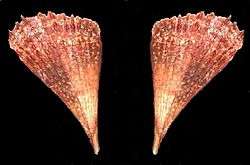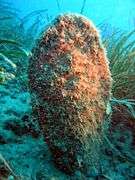Pinna (bivalve)
| Pinna Temporal range: Carboniferous - Recent | |
|---|---|
| | |
| Pinna nobilis shell and byssus | |
| Scientific classification | |
| Kingdom: | Animalia |
| Phylum: | Mollusca |
| Class: | Bivalvia |
| Order: | Pterioida |
| Family: | Pinnidae |
| Genus: | Pinna Linnaeus, 1758 |
Pinna is a genus of bivalve molluscs belonging to the family Pinnidae. The type species of the genus is Pinna rudis.
The most completely studied species in the genus is P. nobilis, a Mediterranean pen shell which was historically important as the principal source of sea silk.
Description
These pen shells can reach a length of about 80–90 cm (31–35 in). They are characterized by thin, elongated, wedge-shaped, and almost triangular shells with long, toothless edges. The surface of the shells shows radial ribs over their entire length.
Pinna is distinguished from its sibling genus Atrina by the presence of a sulcus dividing the nacreous region of the valves, and the positioning of the adductor scar on the dorsal side of shells.
These bivalves most commonly stand point-first in the sea bottom in which they live, anchored by a net of byssus threads.
Distribution
Species in the genus Pinna are geographically widespread. This genus is very ancient, going back up to the Carboniferous period. It is especially represented in Jurassic and Cretaceous fossils.[1]
Species
Species in the genus Pinna include:[1][2][3][4][5]
- P. ampla † Sowerby 1812
- P. bicolor † Gmelin 1791
- P. calamitoides † Shumard.
- P. carnea Gmelin 1791— amber pen shell
- P. constantini † de Loreol & Pellat 1874
- P. cordata † Pritchard 1895
- P. credneri † Gemmellaro 1896
- P. deltodes † Menke 1843
- P. deshayesi † Mayer 1864
- P. dolabrata † Lamarck 1819
- P. dolosoniensis † McLearn 1926
- P. folium † Young and Bird 1822[1]
- P. freneixae † Zinsmeister & Macellari 1988
- P. incurva † Gmelin 1791
- P. incurvata † Sowerby 1825
- P. inermis † Tate 1887
- P. isosceles † Hedley 1924
- P. kawhiana † Marwick 1953
- P. lanceolata † Sowerby 1821[1]
- P. laqueata † Conrad 1858
- P. latrania † Hanna 1926
- P. lima † Boehm 1903
- P. margaritacea † Lamarck 1805
- P. mendenhalli † Hanna 1926[1]
- P. mitis † Zieten 1830
- P. muikadanensis † Nakazawa 1961
- P. muricata † Linnaeus 1758
- P. nobillis Linnaeus, 1758 — noble pen shell
- P. opalina † Quenstedt 1858[1]
- P. pectinata Linnaeus 1758
- P. punjabensis † Eames 1951
- P. qinghaiensis † Lu 1986
- P. radiata † Munster 1837[1]
- P. reginamaris † Maury 1930
- P. rembangensis † Martin 1910
- P. richthofeni † Fliegel 1901
- P. robusta † Chiesa et al. 1995
- P. rudis † Linnaeus 1758
- P. saccata Linnaeus 1758
- P. scapula † Hedley 1924
- P. semicostata † Philippi 1887
- P. semisulcata † Tate 1886
- P. shekhanensis † Eames 1951
- P. sublanceolata † d'Orbigny 1850
- P. tommasii † Wohrmann and Koken 1892[1]
- P. triquetra † Gemmellaro 1896
- P. vexillum † Born 1778
Gallery
 Valves of Pinna carnea
Valves of Pinna carnea A live individual of Pinna nobilis
A live individual of Pinna nobilis- Fossil valve of Pinna folium from Jurassic
- Fossil valve of Pinna ampla from Late Jurassic
- Pinna rudis
References
- Frank H.T. Rodes, Herbert S. Zim en Paul R. Shaffer (1993) - Natuurgids Fossielen (het ontstaan, prepareren en rangschikken van fossielen), Zuidnederlandse Uitgeverij N.V., Aartselaar. ISBN D-1993-0001-361
- Cyril Walker & David Ward (1993) - Fossielen: Sesam Natuur Handboeken, Bosch & Keuning, Baarn. ISBN 90-246-4924-2
- Packard, Earl; Jones, David L. (Sep 1965). "Cretaceous Pelecypods of the Genus Pinna from the West Coast of North America". Journal of Paleontology. 39 (1): 910–915.
- "Glossary". Man and Mollusc. Retrieved 2008-01-30.